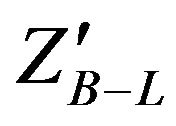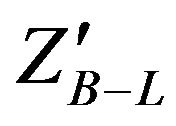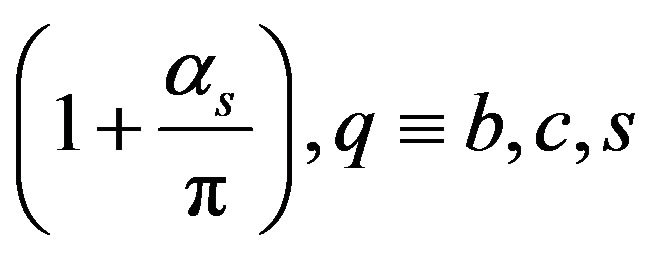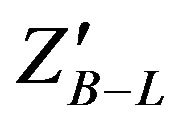Search for High Energy Electrons from New Neutral Massive Gauge Boson Decay in the CMS Detector at the LHC Using Monte Carlo Simulation ()
1. Introduction
The Standard Model (SM) of particles physics provides a good explanation for most known particles but there are several points need an answer, dark matter, dark energy, CP violation to explain the baryonic matter-antimatter asymmetry of the universe and finally neutrino oscillations. From that we can say the SM requires an extension. B-L model is an extension for the SM which is based on the gauge group [1-3]  . The invariance of the Lagrangian under this gauge symmetry implies the existence of a new gauge boson (beyond the SM ones) and the spontaneous symmetry breaking in this model provides a natural explanation for the presence of three right-handed neutrinos in addition to an extra gauge boson and a new scalar Higgs. Therefore, it can lead to a very interesting phenomenology which is different from the SM results and it can be tested at the LHC.
. The invariance of the Lagrangian under this gauge symmetry implies the existence of a new gauge boson (beyond the SM ones) and the spontaneous symmetry breaking in this model provides a natural explanation for the presence of three right-handed neutrinos in addition to an extra gauge boson and a new scalar Higgs. Therefore, it can lead to a very interesting phenomenology which is different from the SM results and it can be tested at the LHC.
An extra neutral massive gauge boson corresponding to the B-L gauge symmetry is predicted. There are many models which contain extra gauge bosons. These models can be classified into two categories depending on whether or not they arise in a GUT scenario. In some of these models,  and SM Z are not true mass due to mixing. This mixing induces the couplings between the extra
and SM Z are not true mass due to mixing. This mixing induces the couplings between the extra  boson and the SM fermions.
boson and the SM fermions.
In the B-L extension of the SM model, the extra  boson and SM fermions are coupled through the nonvanishing B-L quantum numbers. Searching for
boson and SM fermions are coupled through the nonvanishing B-L quantum numbers. Searching for  is accessible via a clean dilepton signal at LHC. We will simulate B-L extension of the SM at LHC which is based on the gauge group
is accessible via a clean dilepton signal at LHC. We will simulate B-L extension of the SM at LHC which is based on the gauge group  using MC programs then search for the
using MC programs then search for the  boson in the dielectron events produced in pp collisions at different energies of LHC where the leptonic decay
boson in the dielectron events produced in pp collisions at different energies of LHC where the leptonic decay  provides the most distinctive signature for observing the
provides the most distinctive signature for observing the  signal at the Large Hadron Collider. The results in this paper were produced by using simulation events generator PYTHIA8 [4-6] and other software tools as CalcHep, MadGraph/Madevent, FeynRules, ROOT data analysis, Physics Analysis Workstation (PAW), ROOFIT package to fit any resulted histogram in order to get P.D.F. (Probability density function) and Mathematica.
signal at the Large Hadron Collider. The results in this paper were produced by using simulation events generator PYTHIA8 [4-6] and other software tools as CalcHep, MadGraph/Madevent, FeynRules, ROOT data analysis, Physics Analysis Workstation (PAW), ROOFIT package to fit any resulted histogram in order to get P.D.F. (Probability density function) and Mathematica.
In this paper, the results are organized into three subsections. Firstly, we present the production of  at LHC which includes production cross section, different branching ratios and total width. Secondly, the detection of
at LHC which includes production cross section, different branching ratios and total width. Secondly, the detection of  signal at LHC via the decay channel
signal at LHC via the decay channel  then we study the dielectron angular distribution, dielectron asymmetry, Drell Yan background events for this channel and dielectron invariant mass. Thirdly, we present the properties of
then we study the dielectron angular distribution, dielectron asymmetry, Drell Yan background events for this channel and dielectron invariant mass. Thirdly, we present the properties of  which include Luminosity, Significance, Transverse momentum and Rapidity.
which include Luminosity, Significance, Transverse momentum and Rapidity.
2. Results
In this section we present our results for production and detection of a  signal of the B-L extension of SM using MC programs [7,8]. We present the production cross section of
signal of the B-L extension of SM using MC programs [7,8]. We present the production cross section of  at LHC as a function of
at LHC as a function of  mass for various
mass for various  values (where
values (where  is the U(1)B–L gauge coupling constant) and for various energies at LHC, branching ratios as a function of
is the U(1)B–L gauge coupling constant) and for various energies at LHC, branching ratios as a function of  mass for heavy neutrino mass = 200 GeV which will affect the results of
mass for heavy neutrino mass = 200 GeV which will affect the results of  due to the fact that it is a heavy particle. We obtained different results in comparison with Ref [9]. The analysis in this paper did not take into account the existence of new decay channel for heavy neutrino in B-L model which is one of the important signatures of B-L model and they did not give any branching ratio for heavy neutrino. After that we will present
due to the fact that it is a heavy particle. We obtained different results in comparison with Ref [9]. The analysis in this paper did not take into account the existence of new decay channel for heavy neutrino in B-L model which is one of the important signatures of B-L model and they did not give any branching ratio for heavy neutrino. After that we will present  total width as a function of
total width as a function of  mass for various values of
mass for various values of . Both angular distribution of dielectron and invariant mass of dielectron produced of
. Both angular distribution of dielectron and invariant mass of dielectron produced of  decay are used to detect
decay are used to detect  signal at LHC. Finally, we will focus on the properties of
signal at LHC. Finally, we will focus on the properties of  such as Luminosity, Significance, Transverse momentum and Rapidity.
such as Luminosity, Significance, Transverse momentum and Rapidity.
2.1. Production of  at LHC
at LHC
2.1.1. Production Cross Section
In Figures 1 and 2 we present the production cross section for  for the most relevant production mechanisms for different CM energies. Figure 1 gives the cross section for
for the most relevant production mechanisms for different CM energies. Figure 1 gives the cross section for  at LHC as a function of
at LHC as a function of  mass for various
mass for various  values (where
values (where  is the U(1)B.L gauge coupling constant) at CM energy of LHC = 14 TeV. Figure 2 gives cross sections for
is the U(1)B.L gauge coupling constant) at CM energy of LHC = 14 TeV. Figure 2 gives cross sections for  at LHC for CM energies √s = 5, 7, 10, 12, 14 TeV at fixed value of
at LHC for CM energies √s = 5, 7, 10, 12, 14 TeV at fixed value of . At the patron level, the
. At the patron level, the  production cross section depends on two main parameters, the mass of
production cross section depends on two main parameters, the mass of  and the coupling constant
and the coupling constant . Therefore, the B-L model is controlled by two parameters: the mass of the
. Therefore, the B-L model is controlled by two parameters: the mass of the  and the coupling constant
and the coupling constant  determining
determining  couplings.
couplings.
Two experimental constraints exist on these two parameters, the first comes from direct search for heavy neutral gauge bosons at the CDF experiment which excludes a  mass less than 600 GeV and the second limit comes from LEP II where:
mass less than 600 GeV and the second limit comes from LEP II where:
 (1)
(1)
The interactions of  boson with the SM fermions in B-L model is described by
boson with the SM fermions in B-L model is described by
 (2)
(2)
where YB–L is the B-L charge associated with the fermions f (see Table 1). The extra neutral gauge boson  acquires a mass due to the B-L gauge symmetry breaking
acquires a mass due to the B-L gauge symmetry breaking
 (3)
(3)
where  is the U(1)B–L gauge coupling constant and υ′ is the symmetry breaking scale.
is the U(1)B–L gauge coupling constant and υ′ is the symmetry breaking scale.
The production cross sections for  signal in Figures 1 and 2 were computed using MadGraph5 and PYTHIA8 where we generated the process pp → ZB–L of B-L model using MadGraph5 and export this process to PHYTHIA8 then the main switches are on for Initial state Radiation(ISR), Final State Radiation(FSR), FSRinResonances, Decay hadronization, allow resonance decays and master switch for multiparton interactions to stay on.
signal in Figures 1 and 2 were computed using MadGraph5 and PYTHIA8 where we generated the process pp → ZB–L of B-L model using MadGraph5 and export this process to PHYTHIA8 then the main switches are on for Initial state Radiation(ISR), Final State Radiation(FSR), FSRinResonances, Decay hadronization, allow resonance decays and master switch for multiparton interactions to stay on.
2.1.2. Branching Ratios of 
In Figure 3, the branching ratios of  to different quarks are equal approximately and for different leptons are higher than those for quarks. Also the branching ratio for heavy neutrino which have mass 200 GeV in our search is less than those for the charged leptons and light neutrinos. In particular,
to different quarks are equal approximately and for different leptons are higher than those for quarks. Also the branching ratio for heavy neutrino which have mass 200 GeV in our search is less than those for the charged leptons and light neutrinos. In particular,  varies between 17% to 17.5% where (l = electron, muon, tau) but for heavy neutrino
varies between 17% to 17.5% where (l = electron, muon, tau) but for heavy neutrino ) varies from 6% to 8% and for light neutrino
) varies from 6% to 8% and for light neutrino  varies between 8.5% to 9% and
varies between 8.5% to 9% and  varies from
varies from

Table 1. B-L quantum number for different particles.
5.5% to 6%. The probabilities that  can decay into one light and one heavy neutrino are highly suppressed by the corresponding (heavy-light) neutrino mixing and thus they can safely be neglected. Heavy neutrino is the most characteristic for B-L model so it has an effect on different branching ratios because it is rather massive than the SM neutrino. From Figure 3 one can search for
can decay into one light and one heavy neutrino are highly suppressed by the corresponding (heavy-light) neutrino mixing and thus they can safely be neglected. Heavy neutrino is the most characteristic for B-L model so it has an effect on different branching ratios because it is rather massive than the SM neutrino. From Figure 3 one can search for  at LHC via a clean dilepton signal which can be one of the first new physics signatures to be observed at the LHC. We will study
at LHC via a clean dilepton signal which can be one of the first new physics signatures to be observed at the LHC. We will study  in this paper by using the decay channel of
in this paper by using the decay channel of  to electrons pair using PYTHIA8 and turn off all other decay channels for
to electrons pair using PYTHIA8 and turn off all other decay channels for  where the ratio of dielctron channel is the highest one.
where the ratio of dielctron channel is the highest one.
2.1.3. Total Width of 
 boson decays only to fermions at tree-level and its width is given by the following expression
boson decays only to fermions at tree-level and its width is given by the following expression
 (4)
(4)
where mf is the mass and Cf the number of colors for the fermion type f. In Figure 4 we present the total decay width of the  as a function of
as a function of  mass for fixed values of
mass for fixed values of . Figure 5 presents the total decay width of the
. Figure 5 presents the total decay width of the  as a function of
as a function of  for fixed values of
for fixed values of  mass.
mass.
From Figures 4 and 5 we note that the total width of a  gauge boson varies from a few hundreds of GeV over a mass range of
gauge boson varies from a few hundreds of GeV over a mass range of  depending on the value of
depending on the value of . The decay widths of
. The decay widths of  in this model are then given by:
in this model are then given by:
 (5)
(5)

 (6)
(6)

 (7)
(7)
The main switches for Initial State Radiation, Final Sate Radiation and multiple interactions are on. Figure 4 presents the total width for  as a function of mass
as a function of mass  for fixed values of
for fixed values of  .Here, we used CM energy of LHC 14 MeV. Figure 5 presents the total width for
.Here, we used CM energy of LHC 14 MeV. Figure 5 presents the total width for  as a function of
as a function of  for fixed values of
for fixed values of  mass. We note that the total width of
mass. We note that the total width of  increase with increasing the mass of
increase with increasing the mass of .
.
In Figure 6 we present the relative variation of the total width as a function of the heavy neutrino mass for different values of  and for
and for . We note the importance of taking into consideration the heavy neutrino since their relative contribution to the total width can be as large as 20% where
. We note the importance of taking into consideration the heavy neutrino since their relative contribution to the total width can be as large as 20% where  is the total width of
is the total width of  which includes all decay channels (also decay channel of heavy neutrino ) whereas
which includes all decay channels (also decay channel of heavy neutrino ) whereas  decoupled includes all decay channels except decay channel of heavy neutrino is turn off.
decoupled includes all decay channels except decay channel of heavy neutrino is turn off.
2.2. Detection of  Signal at LHC
Signal at LHC
2.2.1. Dielectron Angular Distribution
In addition to the dilepton invariant mass  analysis, it has been shown that the angular distribution of the dilepton events [10] can also be used to test the presence of a
analysis, it has been shown that the angular distribution of the dilepton events [10] can also be used to test the presence of a  boson by detecting its interference with the SM Z boson. The massive resonance search technique
boson by detecting its interference with the SM Z boson. The massive resonance search technique
( analysis) is extended to include dilepton angular information to detect
analysis) is extended to include dilepton angular information to detect , so we will use the dielectron angular distribution cos(θ*) where θ* is the angle in the dielectron rest reference frame between the negative electron and the incident incoming quark. PYTHIA8 gives θ only in Lab frame but we use θ* here which is in rest frame so we must convert from lab frame to rest frame to get θ* by using boost vector. We define two additional reference frames: a) the colliding proton CM frame denoted by O (this frame is identical to the laboratory frame) and b) The rest frame of the dilepton system denoted by O*. The dilepton system is boosted along the beam axis. The z-axis is chosen as the direction of one of the beams, and it is then identical for O and O* frames. It should be noted that there is a sign ambiguity in the measurement of cos(θ*) since for a particular event, there is no information about whether the incoming quark comes from the positive or negative z directions [11]. Instead, it is useful to consider the quantity
, so we will use the dielectron angular distribution cos(θ*) where θ* is the angle in the dielectron rest reference frame between the negative electron and the incident incoming quark. PYTHIA8 gives θ only in Lab frame but we use θ* here which is in rest frame so we must convert from lab frame to rest frame to get θ* by using boost vector. We define two additional reference frames: a) the colliding proton CM frame denoted by O (this frame is identical to the laboratory frame) and b) The rest frame of the dilepton system denoted by O*. The dilepton system is boosted along the beam axis. The z-axis is chosen as the direction of one of the beams, and it is then identical for O and O* frames. It should be noted that there is a sign ambiguity in the measurement of cos(θ*) since for a particular event, there is no information about whether the incoming quark comes from the positive or negative z directions [11]. Instead, it is useful to consider the quantity , where
, where  is the angle between the dilepton system boost
is the angle between the dilepton system boost  (relative to the O frame) and the lepton direction
(relative to the O frame) and the lepton direction
 (8)
(8)
where the boost vector is
 (9)
(9)
In order to obtain  the boost vector of the dilepton system should be found and the transformation to the O* frame should be performed. Figure 7 gives the angular
the boost vector of the dilepton system should be found and the transformation to the O* frame should be performed. Figure 7 gives the angular

Figure 7. Angular distribution of dielectron of  boson decay where forward electrons have cos(θ*) > 0 and backward electrons have cos(θ*) < 0.
boson decay where forward electrons have cos(θ*) > 0 and backward electrons have cos(θ*) < 0.
distribution of dielectron of  boson decay as a function of cos(θ*) .
boson decay as a function of cos(θ*) .
2.2.2. Dielectron Asymmetry AFB
In the process  where
where  boson has both vector and axial vector couplings to the fermions, these couplings create an asymmetry in the momentum of the electron visible in the polar angle of the lepton pair's center of mass frame. This polar angle which is measured in the center of mass frame of the leptons is typically referred to as the Collins Soper frame. The angular cross section measured in this frame is given by:
boson has both vector and axial vector couplings to the fermions, these couplings create an asymmetry in the momentum of the electron visible in the polar angle of the lepton pair's center of mass frame. This polar angle which is measured in the center of mass frame of the leptons is typically referred to as the Collins Soper frame. The angular cross section measured in this frame is given by:
 (10)
(10)
Here θ* is the emission angle of the electron relative to the quark momentum in the lepton’s center of mass frame (see Figure 8). The constants A and B are determined by the weak isospin and charge of the incident quarks as well as the mass of the dilepton pair. From this cross section, it is convenient to define Nf as the number of events whose θ* is positive, and Nb as the number of events whose θ* is negative. The asymmetry can then be written as:
 (11)
(11)
This is the general form of the asymmetry.
Collins and Soper noted that an ambiguity exists in the determination of the emission angle θ* when considering

Figure 8. The lepton’s center of mass frame and the CollinsSoper frame.

This Drell-Yan process is quite simple [12] when the incoming quarks have no transverse momentum. In such a case, the emission angle is determined by the angle the electron makes with the proton beam and thus the incoming quark momentum vector. However, since circular acceleration implies a certain amount of transverse momentum by construction, an ambiguity arises. Since the quark’s individual momenta cannot be measured, the momenta boosted into the center of mass frame of the leptons are even more difficult to separate. Consequently, the dependence of the transverse momentum must be minimized. The polar θ* axis is the bisector of the proton beam momentum and the negative (−) of the antiproton beam momentum when the two are boosted into the center of mass frame of the leptons. In so doing, the dependence on the transverse momentum of the incoming quark pair is minimized.
Table 2 shows the numbers of forward and backward electrons produced from  decay in the range of
decay in the range of  mass 500 GeV to 1500 GeV and also asymmetry calculation.
mass 500 GeV to 1500 GeV and also asymmetry calculation.
Figure 9 shows the dielectron asymmetry distribution for forward and backward electrons for various values of  masses.
masses.